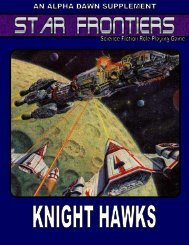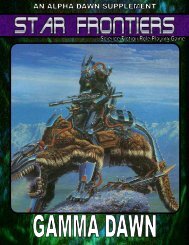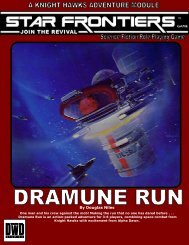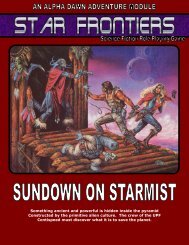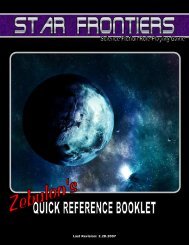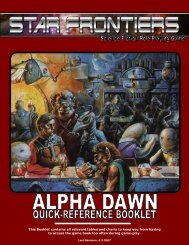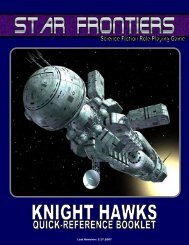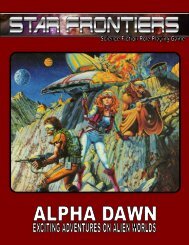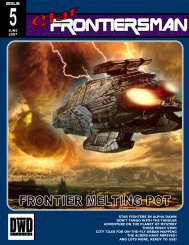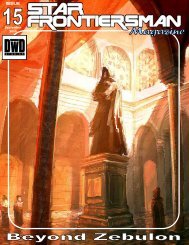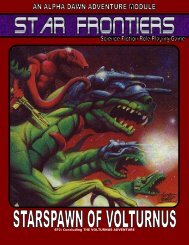Alpha Dawn - Star Frontiersman
Alpha Dawn - Star Frontiersman
Alpha Dawn - Star Frontiersman
Create successful ePaper yourself
Turn your PDF publications into a flip-book with our unique Google optimized e-Paper software.
The Frontier<br />
STAR FRONTIERS adventures take place in an area<br />
of space called the Frontier Sector, or simply the<br />
Frontier. The Frontier contains 17 inhabited star<br />
systems, with a total of 23 colonized planets. Some<br />
of these planets have been claimed and settled by<br />
only one of the four races, while others were set up<br />
in cooperation and have mixed populations.<br />
Besides these settled areas, the sector contains 21<br />
unexplored star systems that could have habitable<br />
(or inhabited) planets. No one has explored the<br />
routes to these stars for navigational hazards, so no<br />
one knows whether these stars even have planets.<br />
Even the settled systems are not fully explored.<br />
There are many moons, asteroid belts and<br />
uninhabited planets that are largely ignored in the<br />
day-to-day business of earning a living in the<br />
Frontier. These areas could hold lost alien treasures<br />
or rich deposits of precious metals and gems.<br />
Because they are isolated, these spots quickly<br />
become hiding places for outlaws and space pirates.<br />
Many of the settled planets themselves are not fully<br />
explored. Most have been mapped by spaceships<br />
and satellites that take pictures from orbit. Very few<br />
have been explored on the ground. When<br />
adventurers travel more than a few hundred<br />
kilometers from a settlement, they are entering an<br />
area where very few people have ever been. They<br />
could be the first people ever to cross that land, or<br />
they could be walking in the footprints of a race that<br />
built a civilization and then collapsed, leaving its<br />
relics to be discovered centuries later.<br />
The Frontier Map<br />
A map of the Frontier Sector is provided for the<br />
referee and the players. The map shows the location<br />
of all the settled systems, unexplored systems,<br />
neutron and binary stars and dust clouds. Each<br />
square is 1 light-year across.<br />
Section 3<br />
Each inhabited planet is described below. Six<br />
characteristics are given for each planet: Colonizers<br />
(Col.), Population and Trade (Pop.), Gravity (Grav.),<br />
Moons and Length of Day.<br />
Population and Trade<br />
This indicates how many intelligent beings live on<br />
the planet and what their major trade is. This<br />
information is given in a two- or three-letter code.<br />
The first letter describes the population, and the<br />
second and third describe the major trade. The<br />
abbreviations are:<br />
Population/Trade<br />
H Heavy Population. The planet has many large cities that<br />
are very crowded, and hundreds of smaller cities.<br />
Individual cities may cover hundreds of square<br />
kilometers.<br />
M Moderate Population. The planet has several large cities<br />
and numerous smaller cities, but they are not<br />
overcrowded.<br />
L Light Population. The planet has only a few cities, and<br />
most would be considered small on a planet with a<br />
Heavy population.<br />
O Outpost. The planet is a small outpost or new colony. It<br />
has only one city, but there may be small settlements<br />
scattered nearby.<br />
I Industry. Most of the planet's economy is based on<br />
manufacturing. Cities are built around factories and<br />
processing plants, and most of the inhabitants work in<br />
these factories. Raw materials may be mined on the<br />
planet or shipped in from other planets.<br />
R Resource Mining. The planet is rich in natural resources<br />
like metals, fossil fuels, gems, crystals or radioactive<br />
materials. Most of these raw materials are shipped to<br />
Industrial planets because there are not enough<br />
factories to process them where they are mined.<br />
A Agriculture. The planet's economy is based on farming.<br />
Any renewable resource can be farmed: grain, lumber,<br />
livestock, fish, fruit, textiles, etc.<br />
Some planets have more than one major trade item.<br />
The trade item that is listed first is most important.<br />
EXAMPLE: Pale, the first inhabited planet at Truane's<br />
<strong>Star</strong>, has a Pop. code of MRI. This means the planet<br />
has a moderate population, and its major trade is<br />
77



